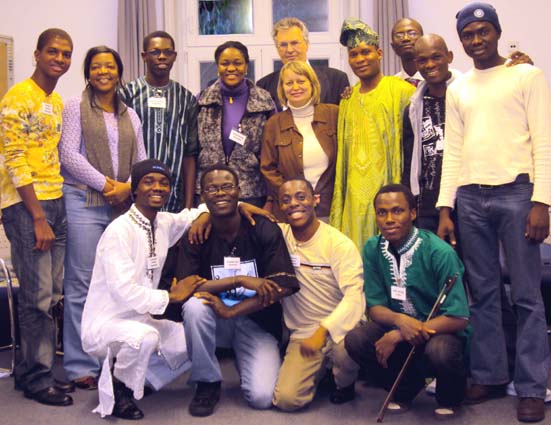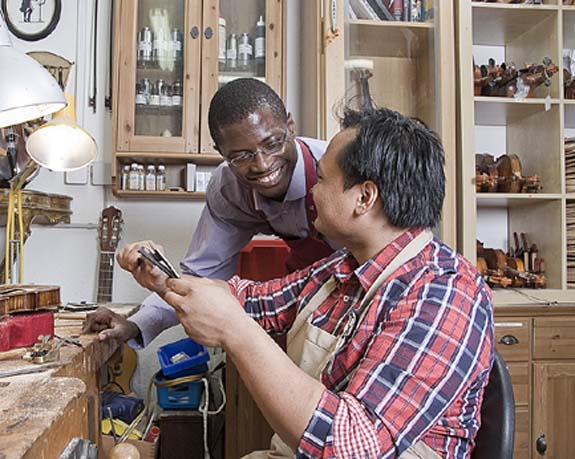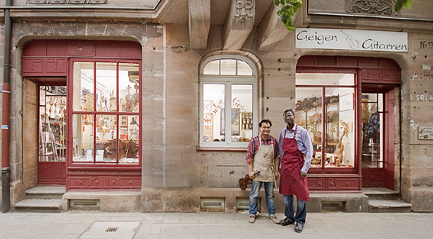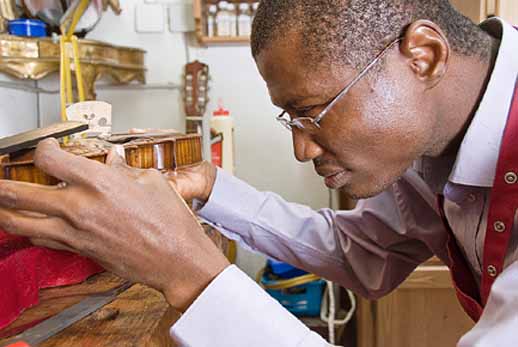A REPORT ON THE TRAINING COURSE
FOR THE REPAIR OF VIOLINS AND VIOLAS
(2 – 30 April 2011)
May I introduce myself?
My name is David Babatunde Awonuga. I am a violinist from Nigeria and studied in Lagos at the largest conservatory of our country. I would like to tell you a wonderful story. You will understand it better if you read the following information about the situation of classical violinists in my country.
Background Survey
Lagos is the former capital of Nigeria with a population of about 10.000.000 and with a long history of violin playing. The Church has been the major patron of violin playing for church music. The oldest orchestras belonged to the Apostolic Faith, then came the Christ Apostolic Church. However, violin playing came to the secular world through other violin players who went to MUSON School of Music (largest Government-recognised, diploma-awarding educational institution dedicated to the training of professional musicians) and were given the stage. Violin playing in Lagos is growing fast, especially in churches like Mountain of Fire, Deeper Life and others. This art has been perfected by MUSON who keep thinking about new ways to improve the art by seeking the help of professionals. The most important step in the Nigerian history of good violin playing now is to train teachers in the Suzuki Method for starting with very young children.
As far back as I can remember, there has not really been any serious activity in the area of violin repair up to now. Most of the players try to fix their instruments by themselves without proper tools and get them fixed wrongly.
The nearest violin maker lives in Ghana (about 2.000 km distance from Nigeria).
In 2010 the German Suzuki Association invited ten young violin teachers from Nigeria to start their training as Suzuki Violin Teachers. It was an exciting course for us. We learned so much about teaching young children, all the little steps to start …
You find me in the last row next to Mr Rudolf Gaehler. If we talk about him we call him just “Pa” and Ms Kerstin Wartberg is of course our “Ma”.

Course 1: 27.02. – 05.03.2010 in Germany
Course 2: 03.10. – 15.10.2011 in Nigeria (!)
After this first Teacher Training Course I understood that we need in Nigeria a good repair service for string instruments if the Suzuki Method is to flourish one day in our country. I decided to learn at least the basic stage of violin and bow repair so that I could repair violins, violas, and bows and to show violin and viola players how to get optimal results from their instruments.
Pre-training
I received a letter of invitation for this training from the German Suzuki Association by UPS post. I also got a letter of introduction from the Director, School of Music, MUSON, Lagos which was very necessary to obtain a visa from the German Embassy. This was my first experience with the embassy directly and it was a bit tough getting a Schengen Visa. I got the visa at the last moment when I was supposed to travel on the 1st of April 15.00hrs and flew with Lufthansa at 21.50hrs through Frankfurt and took a train to Nuremberg.
Host
My German host parents Dr. Ingrid Schlenk and Dr. Rolf Schlenk were waiting to pick me up at the train station in Nuremberg. They offered me a furnished room all to myself with a personal computer, a good study desk and a library of books relevant to my training. I also regularly had very delicious meals and so I was very fit at all times to do my job at the workshop.
Daily Routine at the Violin Shop
The training with my major trainer Philipp Schlenk was really intense. He himself had startet to learn violin with the Suzuki Method at the age of 4. My training with him ran through the week from Monday to Saturday starting from 10.00hrs and ending at about 18.00hrs. I did not train on the Easter Friday and Monday. The violin shop is a modest shop with two interconnected compartments. The bigger one was a sales shop while the smaller one was a workshop. Here is a list of some routine work.
1. Repair of old violins
2. Fitting of bridges (trimming of excess mass)
3. Fitting of pegs, end buttons and tail pieces, guts
4. Fitting of fingerboards and nuts
5. Cleaning and polishing of violins
6. Fitting of sound posts
7. Attending to a customer who wants his violin fixed
8. Arranging the shops at least twice a week
9. Tuning violins and playing a short piece to test the job done
My trainer often gave a lengthy explanation on how to carry out a task, e.g. trimming a bridge, and asked me to practice making several bridges. I practiced on at least ten bridges in order to get the skill for trimming the ears of the bridge to look perfect. It was quite a trouble to handle the knives and many other tools to make the violin parts, but with close supervision of my work I could make such remarkable progress within a short time that my trainer commented that I was the best trainee to have passed through his workshop.
Language
My trainer speaks English and communicates very well in the violin shop so I could understand at least 80 percent of what he said. I also speak a little Deutsch so I could attend to some customers speaking simple Deutsch mixed with English.
Daily Routine at the Bow Shop (8.00 hrs to 16.00hrs)
Unlike the training I had in the violin shop, my training in the bow shop with Andreas Dörfler lasted only two days and a half, but was equally successful because my trainer made me go through all the stages of bow repair and making. I took along with me eight bad bows (4 Cello bows and 4 Violin bows) from Lagos, Nigeria. The bow factory in Bubenreuth is very big and has more than 20 compartments. With my eight bows I could go through many stages of bow repair from one compartment to another and from one staff to another. The stages of bow repair include:
1. Removing the hair
2. Repairing broken bows
3. Making wedges for the frog and the point
4. Bending the bows
5. Fixing new hair and wedges
6. Making new windings for the grip
Due to the short time spent here, I watched more and practiced less. I practiced more, cutting wedges for frog and point. I practiced more, fixing new hair to the bow frames. These were the major aspects of bow repair. However, I learnt that the best way to master the skill was to practice.
Other highlights during my 28 days in Germany include:
1. The opera “ATHALIA” at Meistersingerhalle in Nuremberg
2. Suzuki Children’s Workshop in Fürth (15 – 18. April 2011)
3. A visit to Rothenburg and Schillingsfürst
4. A visit to the Museum
5. A visit to the Zoo (Tiergarten Nuremberg)
6. A visit to a Suzuki group class by Konrad
7. Myself playing viola with the Nuremberg Orchestra (Collegium Musicum)
8. Interview with a freelance journalist
Workshop Tools
Art of mastering the art of repair is practice. I was very worried about returning to Nigeria without all the tools to start with until the last moment when the German Suzuki Association decided to sponsor my workshop tools. I also received many old tools from my trainers, especially from Mr. Philipp Schlenk who gave me at least one tool to start in every area I had covered in violin repair. I also received tools and materials from Mr. Andreas Dörfler. Now I can start my practice in Lagos and I have direct contact with my trainers in Germany in case I need any advice about my work.
I am indebted to this long list of people for their support in making this training a success.
1. German Suzuki Association
2. Suzuki group in Nigeria (under the leadership of Ms Dr. Chinwendum Uzodike)
3. MUSON School of Music
4. Mr. Philipp Schlenk, my master trainer
5. Dr. Ingrid Schlenk and Dr. Rolf Schlenk, my German host parents
6. Mr. Andreas Dörfler, my teacher for bow construction
7. My own family: The Awonugas
Financial
I am most indebted to my Family (the Awonugas) who helped me to raise funds to pay for flying to and from Frankfurt and to my newly-found German family (the Schlenks) who helped to raise funds to fly from Nuremberg to Frankfurt so that I could carry my tools easily. They also made my training most successful by bringing me in contact with the bow factory and the Suzuki Workshop in Fürth as well as by planning my days to be interesting and worth the effort.
I am also thankful to the German Suzuki Association and the Suzuki teachers group in Nigeria for agreeing to pay for the workshop tools and to ship them to Nigeria.
Conclusion /Recommendation
The art of violin repair is best practiced with at least a basic training under the instruction of qualified violin and bow makers. This skill of violin making is as necessary as the skill of violin playing. More people should be encouraged to study other aspects of violin and bow making up to higher levels. Making violins and bows is mainly handwork and does not need many industrial machines. Spruce, maple and ebony also abound in Africa.
If this art is well mastered, Nigerians will soon make violins with their own hands.
Yours
David Babatunde Awonuga
Lagos/Nigeria, 1 May 2011




